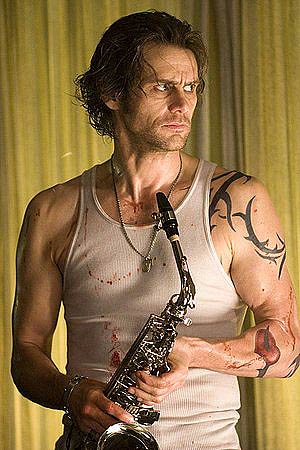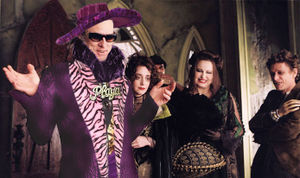Jim Carrey

Jimothy James Carrington (born January 17, 1962), known more notoriously as Jim Carrey (occasionally with "is a wacko" tagged on), is a popular Canadian–American actor who infamously tends to include abundant amounts of allegedly-funny screaming, arm-waving, and face-making in even his more serious roles. While he's appeared in nearly 4,000 films, Carrey is best known for his breathtaking performance in the critically acclaimed and commercially successful Simon Birch. Oh, you haven't seen it? Do yourself a favor: don't.
Despite never winning an Academy Award, and possibly not knowing of the ceremony's existence, Carrey has won Golden Globes on two separate occasions, as well as a record 23 Golden Raspberry Awards since his crawling onto the scene in the 1994 slapstick comedy Ace Ventura: Pet Detective. Since then, Carrey has hit the big time with starring roles in such high-profile films as The Mask (1994), Ace Ventura: Unnecessary Sequel (1995), Jim Carrey's How the Grinch Stole Christmas! (2000), Eternal Moonshine of the Slapstick Mind (2004), Jim Carrey's A Series of Unfortunate Events Movie, Seriously (2004), Yes Man (2008), Jim Carrey's Horton Hears a Who! (2008), Jim Carrey's A Christmas Carol (2009), and Sanic the Hedgehog: The Movie (2020). All this success, or lack thereof, has annoyingly catapulted Carrey into the Hollywood A-list, along with such other misplaced attention-seekers as Keanu Reeves and Pauly Shore.
Early life[edit | edit source]
After several ultrasound scans making their way to conspiracy theorists across America, Jim Carrey finally entered the world on January 17, 1962. His parents were (apparently) Kathleen Carrey, a temporary homemaker, and Percy Carrey, an accountant and musician. Carrey's parents described him as "... very energetic. Jim was always making funny faces and talking in weird accents. We had him diagnosed, and when the only result that came back was ADHD we figured he was a comedian and immediately booked him into the local nightclub." Carrey had three siblings, John, Rita, and Patricia, all of whom had decided from an early age that they would grow up to be a family band, although the idea fell flat once Jim hit it big as a circus animal-slash-actor.
Carrey and his family lived in Burlington, Canada, home to Canada's Largest Ribfest, where Carrey attended Aldershot High School. He was bottom of the class in many subjects, including maths, English, and sexual education, but apparently was outstanding in drama. Carrey's acting teacher wrote in his end of year report: "Carrey was hilarious, eh? He screamed so much we died laughing! His acting is waste yute, but oh how he flailed his arms! It's aboot time someone of such comedic talent came to this school!" In his final year, Jim won several awards, such as "Most Zany", "Most Likely to Star in a Comedy Aboot a Pet Detective or Something", "Most Time Spent Screaming", and the coveted "Weirdest Facial Expressions".
Following high school, Carrey expected to start work in the salt mines, but instead got a low-paying job doing stand-up comedy in a local Yak Yak's. He was quickly banned after attempting to bite the nose off club founder Mark Breslin. Because of this, Carrey moved to Los Angeles, where he joined club The Comedy Store. Carrey was soon banned for much the same reasons, but was noticed by comedian Rodney Dangerfield, who hired Carrey to perform in his tour. Carrey would shout like a maniac, scream something along the lines of "Rodney Dangerfieeeeld!", and jump offstage, to wild laughter from the audience.
Career[edit | edit source]
1980–93: Early career[edit | edit source]
Soon, Carrey quit the tour after noticing that he hadn't received any paycheques for three years. Jobless, he turned his attention to popular NBC sketch show Saturday Night Live, for which he auditioned many times, albeit unsuccessfully. Once his plans to sue NBC failed, Carrey attempted to fashion his own TV show, Carrey's Explosives, about a man named Jesus who creates an evil clone of himself named Robin Williams. The show, which was pitched as a "smart commentary on modern politics", was written and directed by Carrey, who also played all the roles in the show. As the show required little in the way of effects or talent, Carrey barely needed to spend $20 whilst shooting it. After not one station would accept Carrey's pitch for Carrey's Explosives, Carrey sank into a deep depression, which ended only when he got a part in NBC's The Duck Factory, a children's show produced by MTV Enterprise. The Duck Factory fell through the floor after the production and broadcasting of just two critically panned episodes which mainly featured Carrey acting like an angry three-year-old, despite the show winning an Emmy for art direction.
Following this borderline success, Carrey used a back-catalog of smaller roles in film and TV to build up a friendship with Damon Wayans, whose brother was developing the Fox TV comedy show In Living Color. Carrey eventually got a role as a host of characters, and despite being the only white person (or "muthafuckin' crazy whiteboy on crack", as Wayans referred to him), or possibly despite Carrey being part of it at all, the show gained a cult following and received rave reviews. Carrey was catapulted into the limelight, and capitalized on this with a supporting role in the Wayans's comedy Earth Girls Are Easy (1989), and followed up with a string of minor and, luckily, forgotten, film roles before finally starring in Ace Ventura: Pet Detective, the film that would launch Carrey's career off the ground and into a pile of stinking manure.
1994–97: Rise to fame[edit | edit source]
Carrey's first mainstream film role (aside from a series of low-budget arm-waving thrillers distributed by Roger Corman) was as mentally deficient "pet detective" Ace Ventura in the film Ace Ventura: Pet Detective (1994). Carrey was approached by the film's director, Tom "Slim" Shadyac, who had seen Carrey's previous work and decided that Carrey was perfect to play the mannerisms of lead character Ace Ventura. After the film was released, Slim commented on Carrey's performance: "He was pretty good, although he didn't stop screeching and hitting himself once I yelled cut a few times."
The film was a runaway success, grossing $107 million worldwide. Carrey's performance was applauded, with Roger Ebert writing in his review of the film: "Although Ace Ventura: Pet Detective is more of a giant pungent elephant turd than a cinematic failure, lead actor Jim Carey's performance is a supremely sublime commentary about the mentally-impaired, which is in itself a complex yet utterly-simple-in-its-brilliance masterpiece. I think." It also earned Carrey his first film award, albeit a Golden Raspberry for Worst Actor.
Carrey's other two starring roles that year were in The Mask and Dumb and Dumber, which "both would have been better without Carrey" according to critic Richard Roeper. By late 1994 Carrey was a well-known, well-loved/well-hated professional comedy actor, dominating the covers of such magazines as B-Movie, Annoyance Weekly, and MTV Magazine. In 1995, Carrey took a starring role in Joel Schumacher's Batman Forever as the Riddler. According to Schumacher, "I was originally going to make the Riddler the same complex and psychologically unnerving character as in the comics, but when Jim signed on I completely reworked the old script to make sure Jim was at home." After Batman Forever, Carrey reprised his Ace Ventura role in the commercially-precious Ace Ventura: When Nature Calls (1995).
← In 1996 Carrey accepted a record-breaking $40 paycheque to star in the dark comedy The Cable Guy, directed by Sir Bennedict Stiller. The critically-panned film saw Carrey depart from his traditional "screamy shouty maniac" style and enter the far more complex "creepy stalker guy" archetype. Nevertheless, critics dismissed Carrey's effort as "not convincing, funny, bearable, edible, or redeemable" in the words of James Bertnernie.
Predictably, Carrey returned to the expected "gangly madman" character in Liar Liar (1997), which was directed once again by Slim Shadyac, who claimed he "had Carrey in mind" as he wrote the script. Liar Liar received generally positive reviews, a first for Carrey, and grossed a bowel-shattering $300 million worldwide.

1998–2004: Experimental roles[edit | edit source]
The next film Carrey starred in was borderline sci-fi comedy The Truman Show (1998). Although the film featured copious amounts of screaming, arm-waving, and face-making from Carrey's character, it was actually a drama as well as a comedy, and Carrey was reportedly never told this in order to keep him on the project. To make up for the fact that his paycheque for this film was significantly smaller than those from previous films, he was also told that the film contained aliens. Although The Truman Show was nominated for several Academy Awards, Carrey himself did not receive a nomination, leading to him saying "It's an honour just to be nominated ... oh no" and then running off in tears during his Oscar telecast. However, Carrey did win a Golden Globe for his performance, proving once again the generosity of the Golden Globe committee.
In Carrey's third disturbingly critically-successful film in a row, Man on the Moon (1999), Carrey played deceased comedian Andy Kaufman, as he would any other role. Carrey did win a Golden Globe, but critics noted the visible difference in expertise between Carrey and Kaufman himself. For example, Roger Ebert noted: "Whilst watching Man on the Moon, I felt a distinct flurry of emotions; anger, as I resent the fact that Jim Carrey of all people was chosen to play comedic mastermind Andy Kaufman, hate, of Jim Carrey, rage, at the generally downwards-bound quality of the film, and sexual tension, because wow! Does Carrey work out?"
Carrey's next film was Me, Myself and Irene (2000), with which he returned to the Farrelly Brothers, who had directed him in Dumb and Dumber. It was followed by the 2003 comedy Bruce Almighty, again directed by Slim Shadyac, which, despite being identical to most of Carrey's previous work (film's tagline: "if you liked any Jim Carrey movie, you'll like this") grossed a nuclear $85 million on its somewhat disrespectfully-chosen Memorial Day opening weekend, and $484 million worldwide. 6% of this immense sum went to Carrey, who immediately spent it all on bags of pre-roasted marshmallows.
Carrey's next film, Eternal Sunshine of the Spotless Mind (2004), had him playing a man who wipes his memory. Directed by Charlie Kaufman, the film earned lots of money and a Golden Globe nomination for Carrey. The award was nearly given to him, but the committee decided against this at the last moment, saying "He screamed loudly ... yeah, this is pretty much a bandwagon award." Also that year, Carrey played the gloomy, sadistic, overly-atmospheric villain Count Olaf in the gloomy, sadistic, overly-atmospheric Nickelodeon movie A Series of Unfortunate Events: The Movie, based upon the gloomy, sadistic, overly-atmospheric book series of the same name. Carrey hammed up Olaf's theatrical and comedic side, with little of the menace of his book counterpart, angering everyone who wanted the books to be taken seriously as an art form. During this time, Carrey also got a star on the Canadian Walk of Fame for unknown reasons.
2005–2019: Nobody cares[edit | edit source]
Following A Series of Unfortunate Events, the quality of Carrey's films, as well as his popularity, receded to their expected lows. Carrey's next films were the remake Fun with Dick and Jane (2005), about a middle-class couple who resort to robbery when the husband's employer goes bankrupt, The Number 23 (2007), about a dog-catcher who becomes obsessed with the number 23, and Yes Man (2008), about a man who just can't say no to anything, except Zooey Deschanel's off-key singing voice, and gets together with her despite them having no chemistry. Carrey said he had fun acting in 23, as it "gave him opportunities to express his full acting skill." He also starred in Mr. Popper's Penguins (2011), which falls squarely into the "Hollywood bastardizations of children's classics" genre and features a spellbinding mix of live-action Jim Carrey and CGI Jim Carrey.
After finishing filming on Mr. Popper's Penguins, Carrey signed on to make Dumb and Dumber To: The Search for Spock (2014), with the Farrelly Brothers again directing. He expressed delight in doing so, saying that "The original Dumb and Dumber was awesome with me in it and look what happened to the second one without me! Number three has a plot about evil terrorists or something, and I'm writing the script." The film was a box office success, grossing an orgasmic $169 million; however, it received mostly negative reviews, and fans of the original Dumb and Dumber are reportedly in denial about its existence.
2020–present: People care again[edit | edit source]
Carrey made his comeback with the Sanic the Hedgehog: The Movie (2020), where he played Dr. Ivo "Eggman" Robotnik. Carrey brought his usual screaming, arm-waving, and face-making to this role, and also happens to dance in this movie. The Doctor, who had been called "Eggman" in the 3D video games for a while, apparently changed his name back to "Robotnik", lost a ton of weight, and got a hair transplant. Now he works for the military to capture Sanic, who was a tiny alien before he came to Earth. Robotnik wants to steal Sanic's rings (which aren't like Dr. Strange's sling rings), which will allow him to utilize the hedgehog's totally-original powers (which aren't like the Flash) for world domination. He manages to get hold of one of Sanic's magical quills to power his robotic minions. At the end, the Doctor is defeated by Sanic and sent to an alien planet with giant mushrooms, where he goes insane and now looks closer to classic Robotnik from the 2D games (which is how viewers wanted him to look for the whole movie). Against all odds, the film received surprisingly positive reviews and grossed $295 million worldwide, depsite everyone predicting it would be trash.
Personal life[edit | edit source]
Throughout his life, Carrey has married twice and is now a grandfather. His first marriage was to a hopefully female waiter at The Comedy Store (yes, you can buy waiters there) named Melissa Womer. Recalling the night they met, Womer said: "Well, I saw Jim and he leapt on me and we began making out, and the next day we were in the woods and married and hungover. It was probably the alcohol, well, I hope it was the alcohol." Their marriage lasted several days, after which the pair hastily divorced. Unfortunately, Wormer turned out to be pregnant and gave birth to Carrey's first and only child, Jane Erin Carrey, nine months after the divorce. Much, much later, Jane Erin herself had a child, meaning that a dismayed Carrey was now a grandfather.
Carrey's second marriage was to Lauren Holly, a woman he had been working with on the set of Dumb and Dumber. According to Holly's lawyer, Carrey had married her just to impress Wormer, whom he has divorced several hours before his and Holly's wedding. This marriage lasted close to a year, probably because Holly did not know. Apparently, Jim met with Holly in 1997 to tell her they were divorcing; Holly was left confused as Carrey stole her credit card numbers.




